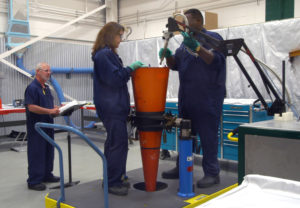And the “consensus” on rebuilding the US nuclear stockpile
The Trump administration’s program to deploy a new, low-yield variant of the W76 warhead carried by U.S. submarine-launched ballistic missiles has faced relatively strong opposition in Congress, with almost all Democrats and several Republicans supporting legislation to eliminate or curb the program.
Indeed, the low-yield warhead is clearly outside the “bipartisan consensus” that supporters have often claimed exists for the Obama administration’s 30-year, $1.7 trillion program to maintain and replace the entire U.S. nuclear stockpile and its supporting infrastructure. Importantly, as I’ll get to later, such a consensus never really existed in the first place.
Congressional roadblocks

Two Pantex production technicians work on a W76 while a co-worker reads the procedure step-by-step. (Photo NNSA)
But let’s start with the new warhead. The attempts to stop it have been noteworthy. A list of most of the votes and amendments on the low-yield option can be found here. Although the final FY19 National Defense Authorization Act (NDAA) that the Senate passed yesterday approves the low-yield warhead, the Appropriations committees—on a bipartisan basis—have generally funded the program but also consistently sought more information on it.
Most recently, on June 28, the Senate Appropriations Committee approved by voice vote an amendment from Sen. Jeff Merkley (D-OR) that would prohibit deployment of the proposed new warhead until Secretary of Defense James Mattis provides Congress with a report that details the implications of fielding it. The Department of Energy (DOE) would still be able to produce the low-yield variant, work that would take place as a part of the ongoing Life Extension Program for the W76 warhead that is scheduled to be completed in Fiscal Year 2019. The W76 warheads have a yield of 100 kilotons; the lower-yield variant will have a yield of 6-7 kilotons.
If nothing else changes, Defense Secretary Mattis should be able to produce the required report in time for deployment to proceed. Although the Navy’s precise timing for deployment is classified, officials have hinted that it should not take more than a year or two. In other words, if the program proceeds as planned, the new warhead could be deployed while President Trump is still in office. Fielding a new weapon in three years or less would be remarkably fast.
But note that phrase “if nothing else changes.” An election is going to happen. There is a chance that Democrats could take the House and (less likely) the Senate. If so, then deployment of the low-yield warhead – and perhaps more pieces of the enormous nuclear rebuilding plan – could come into question.
A rapid response to Trump’s warhead plan
The proposal for the low-yield warhead was included in the Trump administration’s Nuclear Posture Review (NPR), one of two “supplements” to the already ambitious program to revamp the entire nuclear arsenal developed by the Obama administration. (The second supplement is a nuclear-armed sea-launched cruise missile that is many years off.) The NPR described the first supplement as a “near-term” effort to “modify a small number of existing SLBM warheads to provide a low-yield option.”
Democratic opposition to the proposal was swift. When a near-final version of the NPR was leaked to the press in January 2018, sixteen senators wrote a letter to President Trump expressing opposition to the low-yield warhead.
More recently, in May, broader opposition emerged when more than 30 former officials, including former defense secretary William Perry, former secretary of state George Shultz, and former vice chairman of the Joint Chiefs of Staff Gen. James Cartwright (USMC Ret.) wrote a bipartisan letter to Congress calling the new warhead “dangerous, unjustified, and redundant.”
Shortly after that letter was sent, 188 members of the House, including five Republicans and all but seven Democrats, voted in favor of an amendment to the annual NDAA that would have withheld half the funding for the low-yield warhead until Secretary Mattis submitted a report to Congress assessing the program’s impacts on strategic stability and options to reduce the risk of miscalculation. While the amendment failed, it is notable that, in addition to overwhelming Democratic support, five Republicans voted for it.
Then in June, an amendment to the House Energy & Water Development Appropriations Act showed even stronger opposition to the low-yield warhead. Rep. Barbara Lee (D-CA) proposed eliminating all the funding for DOE’s work on the program, in effect killing it outright. This much more aggressive approach received 177 votes, including all but 15 Democrats. Moreover, this vote came after Rep. Lee succeeded in getting the Appropriations Committee to include language requiring Mattis to submit a report on “the plan, rationale, costs, and implications” of the new warhead.
While the Senate has not had any votes on the low-yield warhead on the floor, several Democrats have attempted to cut or fence money for the program in both the Appropriations and Armed Services Committees, culminating in the successful effort by Senator Merkley to prohibit deployment until Secretary Mattis produces a report about the implications of doing so, as highlighted above.
Indeed, both the Senate and House appropriations committees expressed concern that the administration has not provided enough information to make an informed decision about the new weapon.
Will the “bipartisan consensus” unravel?
In the House, it’s clear that a “bipartisan consensus” does not exist for the Obama program to revamp the arsenal, at least not for the program in its entirety. While the recent vote against the Trump administration’s low-yield warhead reflected almost unified opposition to a new weapon by the Democrats, there was similar opposition to the planned Long-Range Stand-Off (LRSO) weapon – the new nuclear-armed air-launched cruise missile – even though it was put forward by the Obama administration. In 2014, 179 House members voted to eliminate funding for the program, including all but 18 Democrats. More recent votes to cut the program back have also enjoyed strong Democratic support.
On the other side of Congress, it has been several years since the Senate has had a floor vote on any nuclear weapons program, so it is harder to judge the level of support for revamping the entire arsenal. Notably, Sen. Jack Reed, the ranking member on the Senate Armed Services Committee, has generally voiced support for the Obama administration’s plan to date. But this year, he led an attempt in the Armed Services Committee to fence funding for deployment of the low-yield warhead, an effort that failed along party lines but became the model for the successful Merkley amendment in the Appropriations committee, on which Sen. Reed also serves. In addition, Sen. Reed also supported a separate Merkley amendment in the Appropriations Committee to eliminate all funding for the low-yield warhead, an attempt that failed largely along party lines.
Clearly, the low-yield warhead is not a part of any “bipartisan consensus.” The question becomes whether the debate over it could be the tipping point that leads to more concerted opposition to some of the new weapons systems in the larger plan, including the LRSO.
That question takes on increased salience when one considers the possibility that Democrats could take the House in elections this fall. While the low-yield warhead likely will be produced in Fiscal Year 2019, its deployment could become a major battle in the new Congress. If that is the case, the supposed “bipartisan consensus” in support of the Obama administration’s plan to replace the entire U.S. nuclear arsenal with a suite of new warheads and delivery vehicles could potentially come unraveled.
